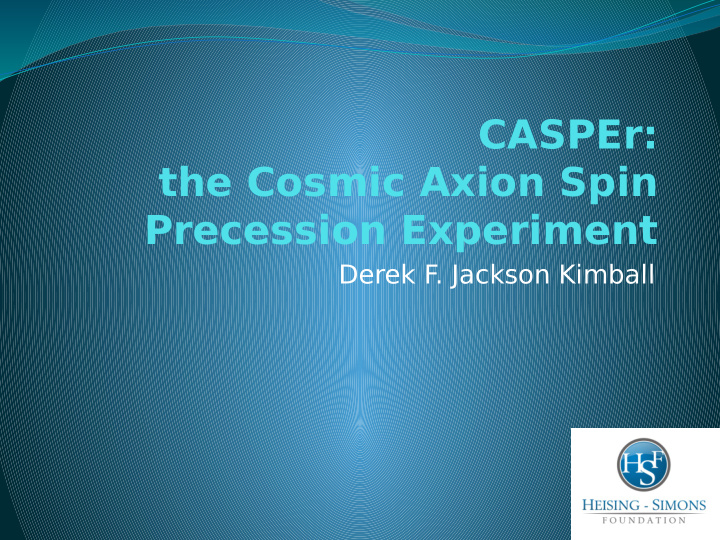



CASPEr: the Cosmic Axion Spin Precession Experiment Derek F . Jackson Kimball
Collaboration
Collaboration
Collaboration Dmitry Budker, Arne Wickenbrock, John Blanchard, Samer Afach, Nathan Leefer, Lykourgas Bougas, Dionysis Antypas (Mainz)
Collaboration
Collaboration
Collaboration Surjeet Rajendran, Dmitry Budker (UCB) Peter Graham (Stanford) Derek Kimball (CSUEB)
Collaboration
Collaboration
Collaboration ? ? Alex Sushkov (Boston University)
Collaboration ? Alex Sushkov (Boston University)
Collaboration
C osmic A xion S pin P recession E xpe r iment (CASPEr) C o s m ic A x io n S p in P r e c e s s io n E x p e r im e n t
D. Budker et al., Phys. Rev. X 4 , 021030 (2014).
Outline Motivation and theory; CASPEr Electric; CASPEr Wind; Conclusions.
Motivation and theory
Axions Axions and axion-like particles (ALPs) arise as the pseudo-Goldstone bosons of global symmetries broken at an energy scale f a . The strong interaction creates a potential for the QCD axion: and the QCD axion mass is given by: ALPs may have difgerent Λ and f .
Axion oscillations When axions are produced after the Big Bang, the fjeld can generally take on any initial value, and thus axions appear as a classical coherent oscillating fjeld.
Axions as dark matter Axion oscillations store energy that can be the dark matter: In fact, if the energy density of the oscillating axion fjeld is too large, it can overclose the universe!
Infmation and axion cosmology If θ QCD ∼ 1 in the early universe, then for the QCD axion: The “anthropic” window However, if the infmation scale is lower than f a the universe before infmation can have an inhomogeneous distribution of a 0 . Any local patch can infmate into our visible universe with a uniform value of a 0 , and of course our visible universe has a dark matter density small enough to avoid overclosure.
Infmation and axion cosmology If θ QCD ∼ 1 in the early universe, then for the QCD axion: The “anthropic” window. CASPEr Astrophysical ADMX constraints GUT scalePlanck scale
Axion couplings Coupling to electromagnetic fjeld Coupling to gluon fjeld CASPEr Electric Coupling to fermions CASPEr Wind
CASPEr Electric
Axion-induced electric dipole moments (EDMs) Nuclear EDM from the strong interaction (strong CP problem): Nuclear EDM from axion fjeld:
Axion oscillation frequency Determined by the axion mass, related to the global symmetry breaking scale f a : f a at GUT scale → MHz frequencies, f a at Planck scale → kHz frequencies.
Axion-induced EDM coupling Assuming axions are the dark matter, the dark matter density fjxes the ratio a 0 / f a : This generates an oscillating EDM:
Nuclear Magnetic Resonance (NMR) NMR resonant spin fmip when Larmor frequency
EDM coupling to axion plays role of oscillating transverse magnetic fjeld SQUID pickup loop Larmor frequency = axion mass ➔ resonant enhancement.
Signal estimate n = atomic density; p = nuclear polarization; SQUID µ = magnetic moment; sensitivity: E * = efgective electric fjeld; ε S = Schifg suppression; Ω L = Larmor frequency.
Sample choice Need maximum n , p , E * , and ε S , and (up to a point) long T 2 . For the fjrst generation CASPEr-Electric experiment, we plan to use a ferroelectric crystal, PbTiO 3 .
Coherence time Coherence length of the axion fjeld is given by its de Broglie wavelength: which translates to a coherence time as the Earth moves through the axion fjeld: with virial velocity:
Coherence time Measured coherence time in PbTiO 3 is T 2 ≈ 1 ms, at cryogenic temperatures T 1 ≈ 1000 s.
Signal estimate Oscillating magnetization is given by: For PbTiO 3 under our experimental conditions:
Experimental strategy (1) Thermally polarize spins in a cryogenic environment at high magnetic fjeld (10 T); (2) Scan magnetic fjeld from 10 T → 0 T; Larmor frequency decreases from 45 MHz; (3) Integrate for about 20 ms at each frequency, a complete scan takes
Experimental strategy Experimental sensitivity
Phase 2 requirements (1) Longer coherence time: T 2 ≈ 1 s. (2) Hyperpolarization: p ≈ 1. (3) Larger sample size: V ≈ 100-1000 cm 3 . R&D required!
CASPEr Wind
Axion/ALP-induced spin precession (axion wind) Nonrelativistic limit of the axion-fermion coupling yields a Hamiltonian:
Axion wind detection SQUID pickup loop axion “wind” Larmor frequency = axion mass ➔ resonant enhancement.
Signal amplifjcation During coherence time τ , polarized spins rotate by angle:
Signal amplifjcation Oscillating fjeld detected by Coil 2 is given by: Enhancement factor!
Sample choice: liquid Xenon Relatively large sample can be hyperpolarized. In this case, the enhancement factor can be on the order of 1 Coupling constant in magnetic fjeld units is:
Experimental setup
Experimental sensitivity
Conclusions New searches for oscillating moments induced by coherent oscillations of the axion/ALP fjeld ofger the possibility to investigate a signifjcant fraction of unexplored parameter space! If research and development of new samples and new hyperpolarization techniques succeed, we may be able to search for the QCD axion with f a near the GUT and Planck scale!
Recommend
More recommend